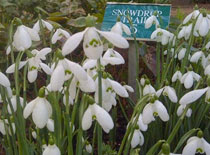A MAGNIFICENT GARDEN CEMETERY
This Garden Cemetery comes in close behind its neighbour Hampstead Heath as my favourite London park. It was rightly called one of the Magnificent Seven - private cemeteries set up outside of London in the 1800s to aid the overcrowded inner-city graveyards.
Highgate Cemetery has a special atmosphere and an atypical wilderness compared to most other city parks. In some places it almost feels as if the plants and trees are slowly creeping in over the graves, which of course were the case from sometime in the 1960s when Highgate Cemetery was abandoned.
Fortunately, Friends of Highgate Cemetery took charge over what was then a deteriorating ruin in 1975 and the charity has worked hard to restore and maintain it ever since.
 |
| Talbot family catacomb also mentioning where the family lived in London. |
THE VICTORIAN WILDERNESS
Though much work has been done and a grand landscape management plan is in progress it is still hard to imagine that this was originally meant to be as neat and manicured as Regent's Park with broad paths, open spaces and easy access to the mausoleums and graves.
 |
| Note the obelisk, a symbol of eternal life and a reflection of the Egyptian revivail during the 19th century. |
I went on a guided tour of the older West Cemetery on a chilly Sunday morning but even so the group was fairly big and consisted of all sorts. Highgate is obviously much more popular than I realised... so come early to avoid waiting.
These guided tours are the only way to visit the older West Cemetery while the East Cemetery is open on a normal basis.
The guide was bubly, helpful and interesting without having to resort to stories of haunting spirits or vampires.
The web is of course full of references to the Highgate Vampire, partly because Bram Stoker set part of Dracula in the cemetery, but apparently it's a bit of a no no to ask about this because of an incident in the 1970s where a small group actually broke into the cemetery and vandalised part of it in search of the vampire.
HIGHLIGHTS FROM THE WEST CEMETERY
Fortunately, Highgate doesn't need a vampire to be interesting. The guide showed us new and old grave monuments, pointed out their elaborate symbolism and talked about the lives of the deceased as well as Victorian burial customs. She even took us inside a mausoleum.
 |
| Cannons turned up-side-down to mark the death of a millitary officer. This grave used to have a glass window in the middle so the family could always see the deceased when they visited. |
Many of graves told the visitor what profession the deceased had occupied in life like the pictures above and below.
Other common symbols were:
- Flaming torches turned upside down to mark the end of the earthly life and the beginning of the eternal life.
- Greek, Egyptian and Roman columns, obelisks and urns reflecting older burial customs and a Victorian fashion imitating classical antiquity. Cremation was still illegal at this time.
- Sleeping angels, especially on the graves of children.
 |
| George Wombwell had one of the more curious jobs in the cemetery |
Thomas Sayers was a boxer, I think you can see a pair of gloves on the top part of his grave. The sleeping dog is not a common grave monument but the symbolism is fairly obvious - who wouldn't want their faithful pet to guard their grave?
GRAVEYARD ARCHITECTURE
These pictures show the elaborate architecture in Highgate Cemetery, another reflection of the Victorian obssession with the ancient empires in Greece, Egypt and Rome. Highgate became a very fashionable place to have your loved ones enterred and the private enterprise made so much money that it could afford these lavish structures. It was of course extra expensive to be buried inside the Egyptian Avenue or the Circle of Lebanon.
 |
| The Egyptian Avenue, complete with lotus flowers and obelisks. It is also built to look longer than it actually is through optical deceit. |
THE EAST CEMETERY
It is a bit much to do both the East and West Cemetery at once in my opinion so these pictures are from a visit in early autumn 2010.
The most famous 'resident' in the East cemetery is probably Karl Marx, whose grav someone attempted to bomb twice...
The sculptor Anna Mahler, daughter of Gustav Mahler is buried in the East Cemetery as well. I really like the sculpture on her grave.
Just a couple of snaps that shows the beautiful and very green East Cemetery:
FIND OUT ABOUT....
Closest tube: Archway, Highgate, Tufnell Park
Highgate Cemetery is split into East and West. West can only be accessed with a guide. Opening times for both is from 10 am. on weekdays and 11 am. on weekends until 5 pm.
Entrance: Adults £3, Students £2






























